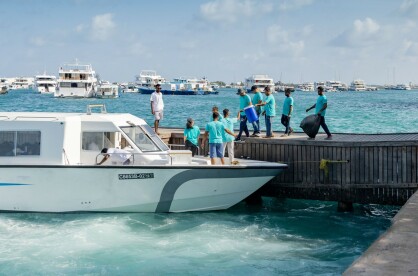In October 2021 the team at MFR covered the theme of decentralization, through articles such as Why decentralization is failing and Decentralizing education. MFR chronicled the journey towards
the goal from an academic and socio-political perspective. We also sat down
with Fathimath Afshan Latheef, CEO of the Local Government Authority (LGA), publishing
the article The decentralisation dream.
Almost a year on, the dialogue
surrounding decentralization, and debate of #RiseRT vs #MM has become louder
and more prominent. Decentralization has come under heavy spotlight, yet again.
What has reinvigorated the debate?
The announcement by Ministry of
National Planning, Housing & Infrastructure on 26th of June 2022
regarding the new housing scheme is what has sparked this heated dialogue. As
MFR penned in the June 2022 article, under this scheme, 3,000
land plots and 4,000 flats from the Greater Male' Regions (GMR) are open for
application.
A Historical Lens on the issue
1.
PRESIDENT MAUMOON ABDUL GAYYOOM
Prior to 2008, the government administration
of Maldives was highly centralized. The President appointed Island and Atoll
Chiefs for each populated island and atoll. The Island Chiefs reported to the
Atoll Chief who reported to the President. All Islands had an Island Development
Committee (IDC).
Communities would make requests to
central government through their Chiefs. The IDCs reported to the Island Chief
who is also a member of the IDC. The Atoll Development Committee report to the
Atoll Chief who reported to the Ministry of Atolls Administration. In addition,
islands were supposed to have an Island Women’s Development Committee (IWDC),
although these were not active on all islands.
With the slow, but steady
vocalization of the distain towards the Presidency, changes were initiated by
President Gayyoom. One such key change was decentralization being at the root
of the constitutional reform process that started in the 1990’s. Consequently,
in 1999 President Gayoom outlined the Maldives Vision 2020 in his Independence
Day speech. According to the research paper, ‘Decentralized-Administration in
The Maldives’, decentralized development was the cornerstone of the 1998
Constitution. However, the National Development Plan of 1998 declared that “the
spatial distribution of the population” was the major challenge in providing
social services costing the state 4 to 5 times more than in other island states
and continental developing countries.
Therefore, the policy-initiative
was to create urban centers so as to disperse the pressure on the capital city
of Male’. However, instead of developing urban centers, Gayyoom embarked on the
development of Hulhumale’. This reclaimed island was developed to address the
land shortages in Male’.
Inadvertently, with the first
residents moving to the island in 2004, it further escalated the decades long
migration chain with thousands of families moving from the atolls. This clearly
went against what was initially planned.
2.
PRESIDENT MOHAMED NASHEED
It is during President’s Nasheed’s
term concrete decentralization work actually started materializing. Soon after
his election, under the discretion accorded to the President in the Article 116
of the Constitution, President Nasheed established provincial offices in 7
regions, with the objective of incorporating the administration of the atolls
into the new administrative framework of the government.
According to a 2013 UNICEF study on
the decentralization process of Maldives, this move by the President was a significant
aspect of the decentralization process. The report further applauded the
decision to establish health corporations, 7 utility corporations and 7
regional education authorities, though acknowledging that there were issues
with their establishments at community level.
A major milestone in the decentralization
process was the ratification of the Decentralization Act on 17th May
2010. This Act specified the administrative offices, posts, atoll and island
councils, responsibilities of the councils, and other guidelines.
As published by the President’s
Office, these changes were being brought to empower citizens through strengthening
local democracy and public accountability, improving the socio-economic and
cultural development of the people, and most importantly to enhance delivery of
public services by bringing services closer to the people.
Consequently, in February 2011, 188
Island Councils, 19 Atoll Councils and 2 City Councils were established, and
representatives elected. The Act paved way for the establishment of the Local
Government Authority (LGA) in late 2010 as well.
3.
PRESIDENT YAMEEN ABDUL GAYYOOM
As the 2013 UNICEF reports, the
change in political power in early 2012 brought an end to the provincialization
process. Subsequently, all the health corporations were dissolved, the utility
corporations were centralized, and changes were brought to the education
authorities.
Essentially any authority that was
transferred away from the center has been re-centralized. As per Ms. Zulfa,
author of the decentralization research paper, this recentralization drive of
2012 to 2018 is deemed unconstitutional prima facie due to the explicit nature
of the provisions of Chapter VIII and the enabling legislation, the
Decentralisation Act.
Centralization continued under
President Yameen’s term. First, development of Hulhumale’ Island Project (Phase
II) started with a loan of USD 80 million from the Saudi Fund. Then came the Hiyaa
Flat Project, prompting more people from the atolls to migrate, eerily similar
to President Maumoon’s time.
This project saw the development of
16 towers with 7,000 flats in the reclaimed suburb, Hulhumale's second phase. The
project, awarded to China State Construction Engineering Corporation (CSCEC),
was undertaken with a USD 437 million loan from the EXIM bank of China along
with a sovereign guarantee from the government, at an interest cost of 6%.
Another link in the chain of centralization
was the Sinamalé Bridge, which cost approximately US$ 210 million. This brings
a total of the 3 projects to USD 727 million. One can only infer the outcomes,
had the projects of this magnitude were to run in an atoll. Surely, the
development and opportunities would have promoted people to move away from this
ever-congested region.
4.
PRESIDENT IBRAHIM MOHAMED SOLIH
The promise of a return to
decentralized administration - under the banner ‘Jazeera Raajje’ was the
foundation of President Solih’s presidential campaign. As MFR stated in the May
2021 article, ‘the promise of “laamarukazee”
rode on the hopes of alleviating the pooling of developmental opportunities
towards the GMR and redirect them back to the islands’.
Since taking oath, there has been
some promising developments in the quest for decentralisation. For example, President
Solih ratified 9th Amendment to Decentralization Act on 23rd
December 2020. Among other changes, the amendment most crucially stipulates the
statutes under which Councils may create and implement policies and regulations
while administering constituents.
Yet, there are projects underway
which blatantly opposes the decentralization narrative. The biggest of which is
the Greater Male’ Connectivity Project (GMCP) Thilamale’ bridge, a mammoth of a
project which will connect Male’, Villimale’, Thilafushi, and Gulhifalhu. This
project is funded by a USD400 million line of credit from Indian Exim Bank and
a USD100 million grant from the Indian government.
With the ongoing Gedhoruverin
housing Scheme and this bridge, there
seems to be more push from the government to flock residents from islands to
the Greater Male’ Region. Imagine, if USD500 million was spent to fully develop
a region in the south and/or north of the country. With the infrastructure and
resources invested in a region like
that, creation of jobs and other
opportunities, is going to help alleviate the crowding in the Male’ region, and
in fact, help with decentralization.
WILL THERE EVER BE MEANINGFUL
DECENTRALISATION?
Irrespective of any administration,
the Maldives has more or less maintained a highly centralized government with
local island councils struggling to play a meaningful role in the political
sphere.
Yet, there are glimmers of hope.
Speaking during the opening ceremony of the third Viavathi Rajje conference
held in Gan Island of Laamu Atoll this September, President Solih addressed the
issue of decentralization. The Maldives Transport Link (RTL) initiative, role
of Councils and the Women's Development Committee (WDC)s, and other infrastructure
development projects were described to facilitate the decentralization process.
However, the question still looms on how effective these investments are with the
heavy housing projects still underway in the Greater Male’ Region.







